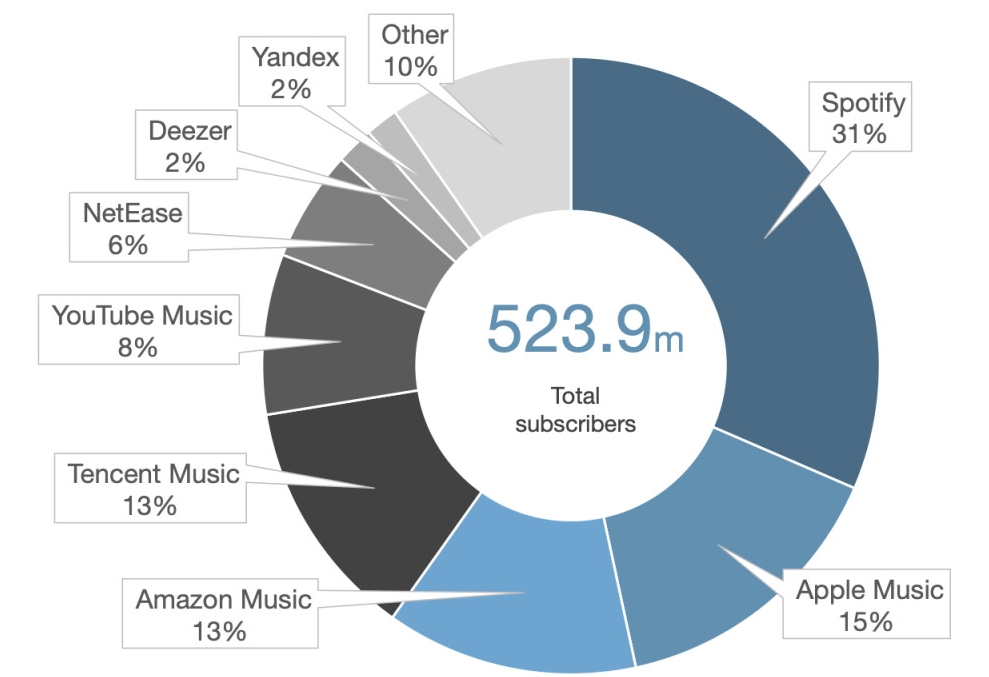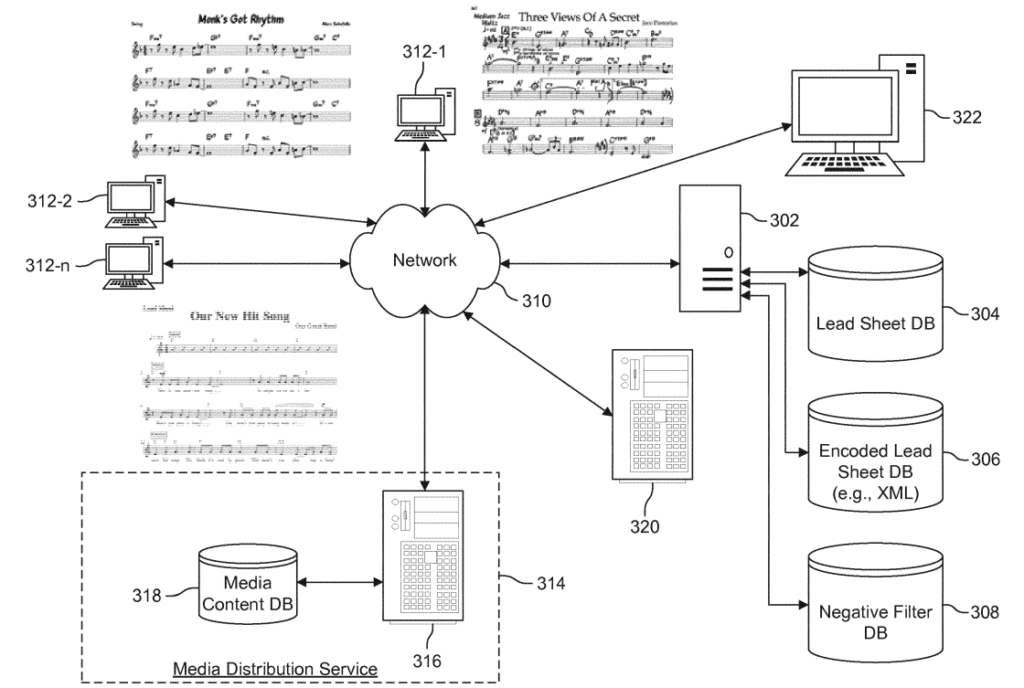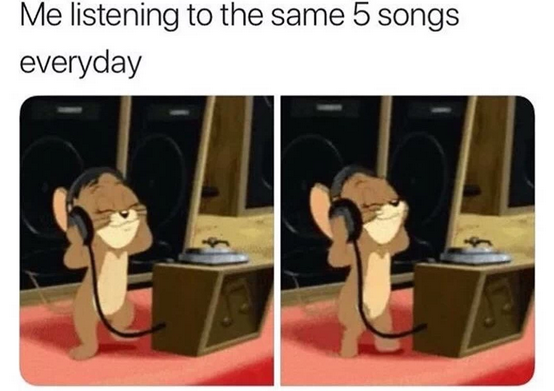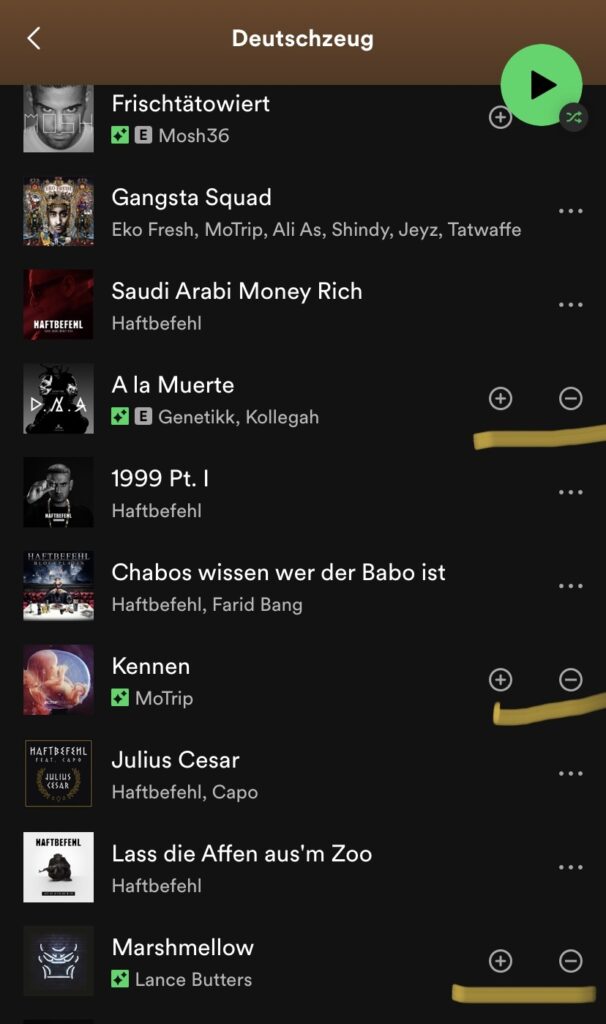Spotify: Fighting Commoditization with AI

Learn how Swedish innovator Spotify keeps the worlds biggest tech companies at bay by creating value through AI-driven innovation for content consumers and creators – or judge me for my 2014 music taste.
Music Streaming: An Attractive Market?
The global market for music streaming services is still growing strongly. According to MIDiA’s annual music subscriber market shares report the number of subscribers grew by 109.5 million (26%) between Q2/2020 and Q2/2021 bringing the total number to an impressive 523.9 million of global subscribers [1]. No wonder that all global tech giants have by now launched an offering to get a piece of that pie. Yet, the unexpected king of the hill remains the comparatively small Swedish company Spotify, doubling the market share of their closest competitors.

On the other hand, music streaming is at risk of becoming a commodity product. Most major artists and record labels are available on all streaming platforms which makes it hard for any platform to differentiate itself from its competitors. This is also reflected in the uniform pricing across platforms. All the major Western platforms – Spotify, Apple Music, Amazon Music, Youtube Music – have adopted an almost identical pricing structure, offering an individual subscription for $9.99/month, a family/household subscription for $14.99/month (Spotify: $15.99/month) and a student subscription for $4.99/month (Amazon: $0.99/month). One differentiation strategy that Spotify has pursued in recent years is to differentiate themselves through exclusive non-music content, most notably podcasts. Yet, the controversy around the $200M Joe Rogan deal [2] has shown that the transition from content hosting to quasi-publishing is not without its own set of risks.
Spotify’s focus has been to differentiate themselves from their competitors through digital and data-driven innovations that add value for their users. They target all relevant parties in the music streaming ecosystem: content creators, content consumers and relevant third parties such as car manufacturers, e.g. Porsche [3]. Concretely, AI technology has opened up a lot of possibilities for new products and features and in the following case studies we will discover how two innovations, at different levels of maturity and for different parties in the ecosystem, create value for their users.
AI-powered Innovation for Creators: Plagiarism Detection
Creators of global hits getting sued for plagiarism has become more and more common in recent years. In a high profile case Robin Thicke and Pharell Wiliams were ordered to pay $7.2 million in damages because of the similarity of their hit song “Blurred Lines” to Marvin Gaye’s “Got To Give It Up” [4]. Given the somewhat limited set of melodies and chord sequences in modern pop music, it can be hard for a music creator to be sure that parts of their song are not too similar to existing compositions, especially if those are not widely known. Today preventive plagiarism detection to avoid potential lawsuits is a primarily manual process which, according to Spotify, “requires substantial effort, skill and excellent memory, and is generally known to be impractical” [5].
Spotify tackles this problem in a recent filing with the European Patent Office in which they present an AI-driven, easy-to-use and real time plagiarism detection tool [5]. The AI-driven plagiarism detector will be “trained on a plurality of preexisting encoded lead sheets” and is then used by artist who can simply enter the lead sheet of their newest creation. The plagiarism detector then discovers in real time if the entered music is similar to existing pieces in terms of e.g., chord sequence, melodic fragments, harmony. If no similar songs are detected the artist can rest assured that his creation is completely original and there is no risk of litigation lawsuits. If a similarity is detected the artist can directly listen to the similar works and make adjustments if necessary.

As the tool can be used by artists with little technical expertise, it allows the detection and prevention of potential plagiarism very early in the process, i.e. before a lot of money has been spent on recording the music. This invention has the potential to become a staple tool for creators around the world and could thus help Spotify strengthen their relationship with the artist community.
AI-powered Innovation for Consumers: Enhance Playlists
Helping people users discover new music that they might like to keep them engaged is one of the major challenges all music streaming providers want to solve. Yet, getting people to click and commit to an entirely new album or playlist can be difficult. With one of their newest features Spotify thus tries to meet people where they feel the most at home: their own playlists.

Pressing the mysterious “Enhance Playlist” button adds around 30 new songs to a playlist that fit the other songs and the mood of the playlist. This is done via Spotify’s AI-based capabilities to cluster and classify songs which form the basis for their personalized song and playlist recommendations. The new songs are only tentatively added to the playlist and highlighted by additional UI elements. The user can now listen to the suggested songs and either add them to the playlist by pressing (+) or discard the algorithms recommendation by pressing (-). A nice little benefit is that Spotify can use this focused feedback to further train and improve their clustering and recommendation algorithms.

To stress test this feature I tried it for an obscure genre, namely my German gangster rap playlist from 2014 (please do not judge me too harshly for my music taste at 18) and found the recommendation to be well fitting with the (admittedly somewhat dubious) mood of the playlist. This features makes me excited to go back to some of my other playlists, that I have not listened to in a while because they have grown stale, and spice them up with some new songs. The combination of strong AI-powered recommendations and its intuitive and slick UI make this a value-adding feature for me and other users.
Conclusion
Having some of the world’s biggest and most powerful companies on their tails in a competitive market environment, Spotify will only be able to keep their spot at the top by continuing to innovate and refine their core offering with well-designed features and supporting products. Their focus on technology and innovation in combination with their forward-looking overall strategy make me optimistic for Europe’s only top-tier customer-facing tech company.
Sources
[1] https://www.midiaresearch.com/reports/music-market-subscriber-shares-2021-growth-is-not-letting-up-yet
[2] https://www.nytimes.com/2022/02/17/arts/music/spotify-joe-rogan-misinformation.html
[3] https://newsroom.porsche.com/en/2022/products/porsche-communication-management-pcm-infotainment-system-update-27152.html
[4] https://www.rollingstone.com/music/music-news/robin-thicke-pharrell-lose-multi-million-dollar-blurred-lines-lawsuit-35975/
[5] https://data.epo.org/publication-server/document?iDocId=6403518



Hey Chris, I really enjoyed reading your blogpost.
It would be interesting to see if Spotify can somehow recycle their plagiarism detection algorithm and use it in music creation software to suggest to artists which chord progressions are less used, which ones are more popular etc….
Thanks for sharing, Chris. Rest assured we do not judge you too harshly (I wholeheartedly believe that each of our 2014 playlists would be ripe for discussion had we all shared). I find the algorithm that helps artists avoid plagiarism particularly interesting and I wonder if parts of it would also be able to pick up on what makes a “hit” song with the ability to also engineer what might constitute as a “hit” or “popular” tune? I also wonder if artists or labels have to pay to leverage this AI capability and if this is a source of revenue for Spotify? Lastly, if an artist is identified by the AI to having potential components of plagiarism, have there been any use cases of the artist continuing to share anyway? Awesome read, really enjoyed your post!